CRUD Operation Using Entity Framework Core and Stored Procedure in .Net Core 6 Web API
A step-by-step tutorial on the CRUD operation implementation of Web API using entity framework core and stored procedure with guide pictures and code.
Join the DZone community and get the full member experience.
Join For FreeIn this article, we are going to discuss the implementation of Web API using entity framework core and stored procedure.
Prerequisites
- .NET Core SDK 6
- SQL Server
- Visual Studio 2022
Agenda
- Implementation of .NET Core 6 Web API
- Implementation of stored procedures
Implementation of .NET Core 6 Web API
Step 1
Create a new .NET Core Web API application.
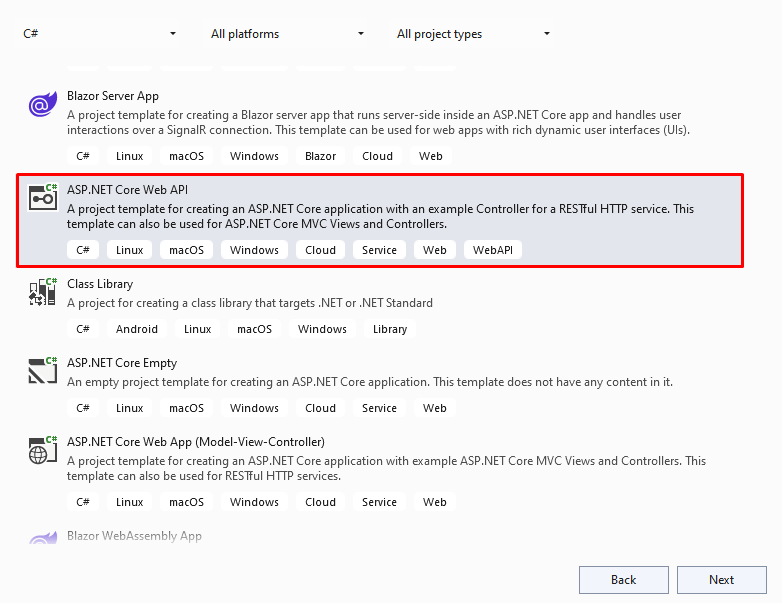
Step 2
Configure the application.

Step 3
Provide additional information.
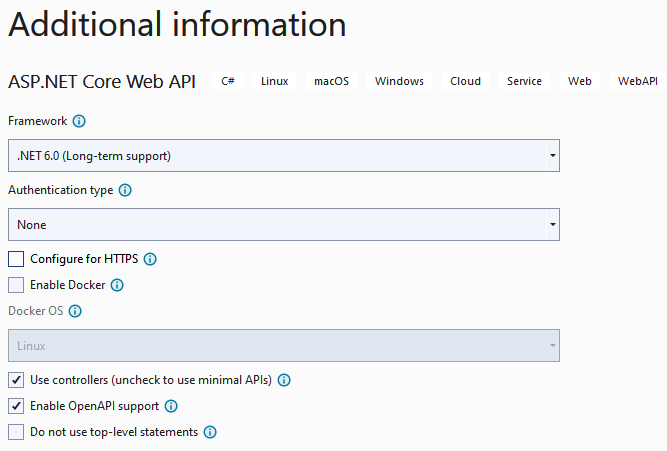
Step 4
Project structure
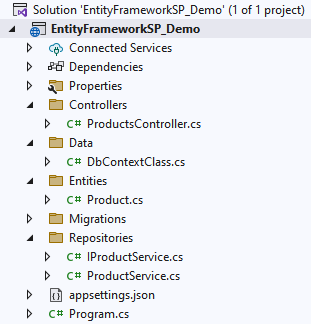
Step 5
Create a product class inside the "Entities" folder.
using System.ComponentModel.DataAnnotations;
namespace EntityFrameworkSP_Demo.Entities
{
public class Product
{
public int ProductId { get; set; }
public string ProductName { get; set; }
public string ProductDescription { get; set; }
public int ProductPrice { get; set; }
public int ProductStock { get; set; }
}
}Step 6
Add a new DbContextClass inside the "Data" folder.
using EntityFrameworkSP_Demo.Entities;
using Microsoft.EntityFrameworkCore;
namespace EntityFrameworkSP_Demo.Data
{
public class DbContextClass : DbContext
{
protected readonly IConfiguration Configuration;
public DbContextClass(IConfiguration configuration)
{
Configuration = configuration;
}
protected override void OnConfiguring(DbContextOptionsBuilder options)
{
options.UseSqlServer(Configuration.GetConnectionString("DefaultConnection"));
}
public DbSet<Product> Product { get; set; }
}
}Step 7
Create IProductService and ProductService inside the "Repositories" folder.
IProductService:
using EntityFrameworkSP_Demo.Entities;
namespace EntityFrameworkSP_Demo.Repositories
{
public interface IProductService
{
public Task<List<Product>> GetProductListAsync();
public Task<IEnumerable<Product>> GetProductByIdAsync(int Id);
public Task<int> AddProductAsync(Product product);
public Task<int> UpdateProductAsync(Product product);
public Task<int> DeleteProductAsync(int Id);
}
}ProductService:
using EntityFrameworkSP_Demo.Data;
using EntityFrameworkSP_Demo.Entities;
using Microsoft.Data.SqlClient;
using Microsoft.EntityFrameworkCore;
namespace EntityFrameworkSP_Demo.Repositories
{
public class ProductService : IProductService
{
private readonly DbContextClass _dbContext;
public ProductService(DbContextClass dbContext)
{
_dbContext = dbContext;
}
public async Task<List<Product>> GetProductListAsync()
{
return await _dbContext.Product
.FromSqlRaw<Product>("GetPrductList")
.ToListAsync();
}
public async Task<IEnumerable<Product>> GetProductByIdAsync(int ProductId)
{
var param = new SqlParameter("@ProductId", ProductId);
var productDetails = await Task.Run(() => _dbContext.Product
.FromSqlRaw(@"exec GetPrductByID @ProductId", param).ToListAsync());
return productDetails;
}
public async Task<int> AddProductAsync(Product product)
{
var parameter = new List<SqlParameter>();
parameter.Add(new SqlParameter("@ProductName", product.ProductName));
parameter.Add(new SqlParameter("@ProductDescription", product.ProductDescription));
parameter.Add(new SqlParameter("@ProductPrice", product.ProductPrice));
parameter.Add(new SqlParameter("@ProductStock", product.ProductStock));
var result = await Task.Run(() => _dbContext.Database
.ExecuteSqlRawAsync(@"exec AddNewProduct @ProductName, @ProductDescription, @ProductPrice, @ProductStock", parameter.ToArray()));
return result;
}
public async Task<int> UpdateProductAsync(Product product)
{
var parameter = new List<SqlParameter>();
parameter.Add(new SqlParameter("@ProductId", product.ProductId));
parameter.Add(new SqlParameter("@ProductName", product.ProductName));
parameter.Add(new SqlParameter("@ProductDescription", product.ProductDescription));
parameter.Add(new SqlParameter("@ProductPrice", product.ProductPrice));
parameter.Add(new SqlParameter("@ProductStock", product.ProductStock));
var result = await Task.Run(() => _dbContext.Database
.ExecuteSqlRawAsync(@"exec UpdateProduct @ProductId, @ProductName, @ProductDescription, @ProductPrice, @ProductStock", parameter.ToArray()));
return result;
}
public async Task<int> DeleteProductAsync(int ProductId)
{
return await Task.Run(() => _dbContext.Database.ExecuteSqlInterpolatedAsync($"DeletePrductByID {ProductId}"));
}
}
}FromSqlRawmethod is used to execute SQL commands against the database and returns the instance of DbSet.
ExecuteSqlRawAsyncis used to execute the SQL commands and returns the number of rows affected.
ExecuteSqlInterpolatedAsyncexecutes SQL command and returns the number of affected rows.
Step 8
Add database connection string inside the appsettings.json file.
{
"Logging": {
"LogLevel": {
"Default": "Information",
"Microsoft.AspNetCore": "Warning"
}
},
"AllowedHosts": "*",
"ConnectionStrings": {
"DefaultConnection": "Data Source=DESKTOP;Initial Catalog=StoredProcedureEFDemo;User Id=sa;Password=database;"
}
}Step 9
Register services inside the program class.
using EntityFrameworkSP_Demo.Data;
using EntityFrameworkSP_Demo.Repositories;
var builder = WebApplication.CreateBuilder(args);
// Add services to the container.
builder.Services.AddScoped<IProductService, ProductService>();
builder.Services.AddDbContext<DbContextClass>();
builder.Services.AddControllers();
// Learn more about configuring Swagger/OpenAPI at https://aka.ms/aspnetcore/swashbuckle
builder.Services.AddEndpointsApiExplorer();
builder.Services.AddSwaggerGen();
var app = builder.Build();
// Configure the HTTP request pipeline.
if (app.Environment.IsDevelopment())
{
app.UseSwagger();
app.UseSwaggerUI();
}
app.UseAuthorization();
app.MapControllers();
app.Run();Step 10
Create a new product controller.
using EntityFrameworkSP_Demo.Entities;
using EntityFrameworkSP_Demo.Repositories;
using Microsoft.AspNetCore.Http;
using Microsoft.AspNetCore.Mvc;
using System.Collections.Generic;
namespace EntityFrameworkSP_Demo.Controllers
{
[Route("api/[controller]")]
[ApiController]
public class ProductsController : ControllerBase
{
private readonly IProductService productService;
public ProductsController(IProductService productService)
{
this.productService = productService;
}
[HttpGet("getproductlist")]
public async Task<List<Product>> GetProductListAsync()
{
try
{
return await productService.GetProductListAsync();
}
catch
{
throw;
}
}
[HttpGet("getproductbyid")]
public async Task<IEnumerable<Product>> GetProductByIdAsync(int Id)
{
try
{
var response = await productService.GetProductByIdAsync(Id);
if(response == null)
{
return null;
}
return response;
}
catch
{
throw;
}
}
[HttpPost("addproduct")]
public async Task<IActionResult> AddProductAsync(Product product)
{
if(product == null)
{
return BadRequest();
}
try
{
var response = await productService.AddProductAsync(product);
return Ok(response);
}
catch
{
throw;
}
}
[HttpPut("updateproduct")]
public async Task<IActionResult> UpdateProductAsync(Product product)
{
if (product == null)
{
return BadRequest();
}
try
{
var result = await productService.UpdateProductAsync(product);
return Ok(result);
}
catch
{
throw;
}
}
[HttpDelete("deleteproduct")]
public async Task<int> DeleteProductAsync(int Id)
{
try
{
var response = await productService.DeleteProductAsync(Id);
return response;
}
catch
{
throw;
}
}
}
}Step 11
Execute the following command to create migration and update the database in the package manager console.
add-migration "Initial"
update-database
Step 12
Implementation of stored procedures
GetPrductList:
USE [StoredProcedureEFDemo]
GO
/****** Object: StoredProcedure [dbo].[GetPrductList] Script Date: 10/16/2022 11:08:29 AM ******/
SET ANSI_NULLS ON
GO
SET QUOTED_IDENTIFIER ON
GO
CREATE OR ALTER PROCEDURE [dbo].[GetPrductList]
AS
BEGIN
SELECT * FROM dbo.Product
END
GOGetPrductByID:
USE [StoredProcedureEFDemo]
GO
/****** Object: StoredProcedure [dbo].[GetPrductByID] Script Date: 10/16/2022 11:09:04 AM ******/
SET ANSI_NULLS ON
GO
SET QUOTED_IDENTIFIER ON
GO
CREATE OR ALTER PROCEDURE [dbo].[GetPrductByID]
@ProductId int
AS
BEGIN
SELECT
ProductId,
ProductName,
ProductDescription,
ProductPrice,
ProductStock
FROM dbo.Product where ProductId = @ProductId
END
GOAddNewProduct:
USE [StoredProcedureEFDemo]
GO
/****** Object: StoredProcedure [dbo].[AddNewProduct] Script Date: 10/16/2022 11:09:20 AM ******/
SET ANSI_NULLS ON
GO
SET QUOTED_IDENTIFIER ON
GO
CREATE OR ALTER PROCEDURE [dbo].[AddNewProduct]
@ProductName [nvarchar](max),
@ProductDescription [nvarchar](max),
@ProductPrice int,
@ProductStock int
AS
BEGIN
INSERT INTO dbo.Product
(
ProductName,
ProductDescription,
ProductPrice,
ProductStock
)
VALUES
(
@ProductName,
@ProductDescription,
@ProductPrice,
@ProductStock
)
END
GOUpdateProduct:
USE [StoredProcedureEFDemo]
GO
/****** Object: StoredProcedure [dbo].[UpdateProduct] Script Date: 10/16/2022 11:09:38 AM ******/
SET ANSI_NULLS ON
GO
SET QUOTED_IDENTIFIER ON
GO
CREATE OR ALTER PROCEDURE [dbo].[UpdateProduct]
@ProductId int,
@ProductName [nvarchar](max),
@ProductDescription [nvarchar](max),
@ProductPrice int,
@ProductStock int
AS
BEGIN
UPDATE dbo.Product
SET
ProductName = @ProductName,
ProductDescription = @ProductDescription,
ProductPrice = @ProductPrice,
ProductStock = @ProductStock
WHERE ProductId = @ProductId
END
GODeletePrductByID:
USE [StoredProcedureEFDemo]
GO
/****** Object: StoredProcedure [dbo].[DeletePrductByID] Script Date: 10/16/2022 11:09:50 AM ******/
SET ANSI_NULLS ON
GO
SET QUOTED_IDENTIFIER ON
GO
CREATE OR ALTER PROCEDURE [dbo].[DeletePrductByID]
@ProductId int
AS
BEGIN
DELETE FROM dbo.Product where ProductId = @ProductId
END
GOStep 13
Finally, run the application:
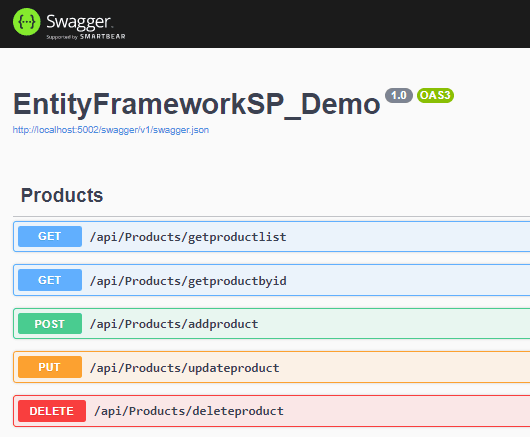
http://localhost:5002/api/Products/getproductlist

http://localhost:5002/api/Products/getproductbyid?Id=16

http://localhost:5002/api/Products/addproduct
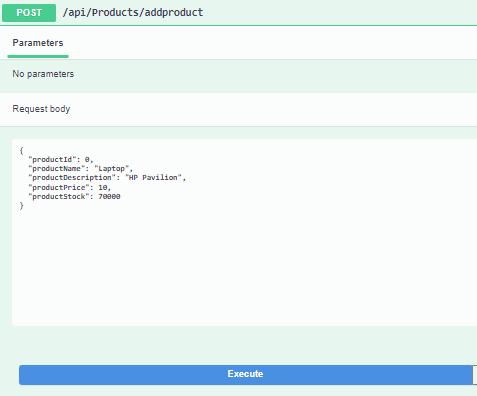
http://localhost:5002/api/Products/updateproduct
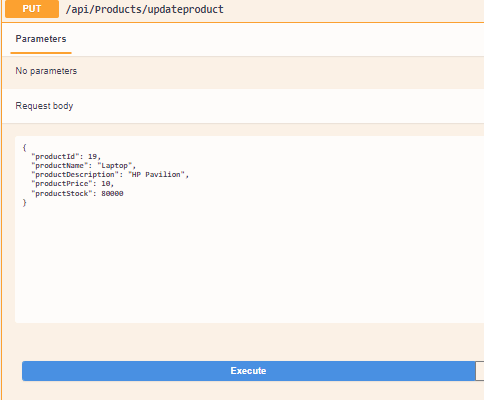
http://localhost:5002/api/Products/deleteproduct?Id=19
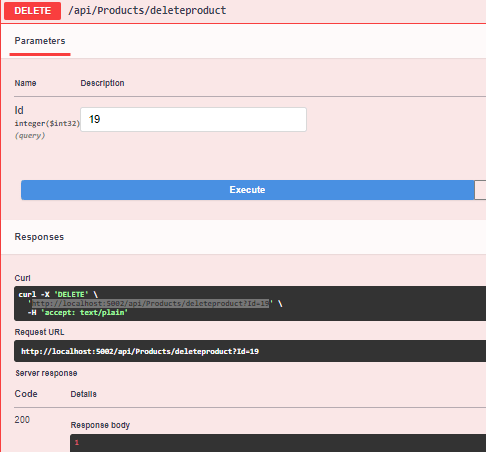
The GitHub repository for this tutorial is available here.
Conclusion
Here we discussed the implementation of Web API using Entity Framework Core and stored procedure.
Happy learning!
Published at DZone with permission of Jaydeep Patil. See the original article here.
Opinions expressed by DZone contributors are their own.

Comments